I WANT
RELATED LINKS
I WANT
RELATED LINKS
RELATES LINKS
I WANT
RELATES LINKS
Services
Related Links
Use and Management of Cookies
We use cookies and other similar technologies on our website to enhance your browsing experience. For more information, please visit our Cookies Notice.
- Personal Banking
- Stories & Tips
- Life Style
- Explore Kelang City, Lampang Province
- Personal Banking
- ...
- Explore Kelang City, Lampang Province
Explore Kelang City, Lampang Province
21-08-2018
The ancient city of Lanna Thai or Lampang in the past, it was a trade center of the North. Have prosperity the historical significance of not less than 1,300 years since Haripunchai. There are many names in the past; Sridonchai, Lampakampa Nakorn, Kukut Nakorn (White chicken city) and Kelang. Before people often called Lampang people Jaolakon people. Lakon is a Pali language and it means Kelang as well. The location of the Kelang city is located on the west of the Wang River, Wiang Nuea sub-district, Muang District, Lampang Province.
Lampang is one of the Lanna civilizations that no less attractive than any other province in Northern Thailand. Unique identity to impress visitors are temples and houses are filled with valuable architecture, horse carriage, pottery and Lampang people who have a simple life style and warm hearts. Lampang people also keep the traditions that traditionally inherited the ancient. Before tourists may think that Lampang is a small town and they just pass by. But, is not right. People who have come to visit all found that Lampang is above expectations. It is a trip that make your heart smile and friendly for your pocket.
Wat Phra That Lampang Luang Temple (วัดพระธาตุลำปางหลวง)
Wat Phra That Lampang Luang is a beautiful and sacred temple of Lampang for a long time. One of the most beautiful wooden temples in Thailand. It is believed to have been created since the reign of Phra Nang Jamma Devi. The interior is full of historic sites. It is enshrined for Phra Kaew Don Tao (emerald buddha). Wat Phra That Lampang Luang is a temple of the relics of the year of the Ox. There is also a museum that collect rare collections such as Buddhist scriptures cabinet, pulpit.
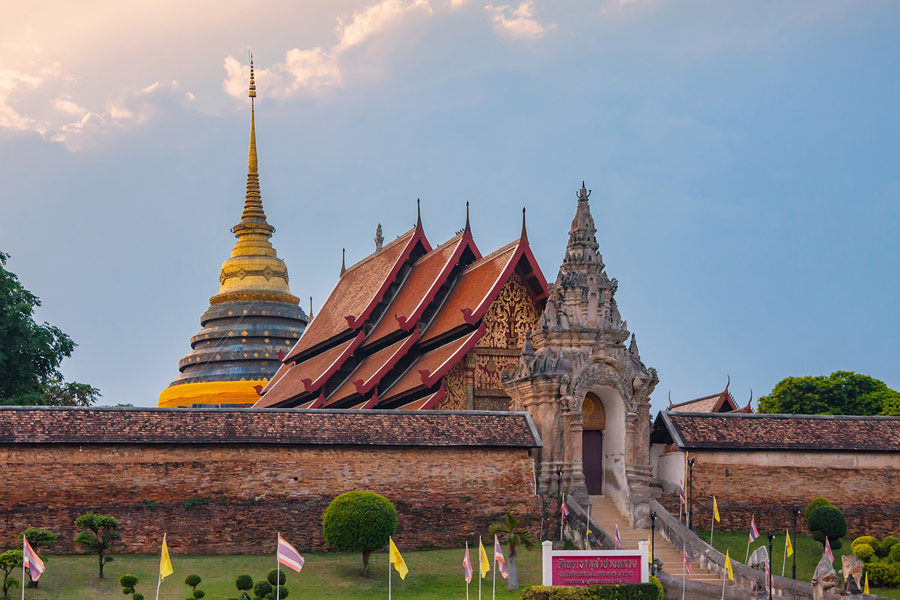
And do not miss the shadow of the pagoda head back near Buddha image hall and The footprint of the Buddha that many people find it a miracle and difficult to find. Lampang also has many historical monuments to get blessings.
Address: Lampang Luang, Ko Kha District, Lampang
Ratsadaphisek Bridge, Ratsada Market (สะพานรัษฎาภิเศก ตลาดรัษฎา)
Ratsadaphisek is another symbol of Lampang. The most beautiful bridge of the city of Lampang. The two sides of the bridge decorated with white chicken symbol of Lampang and Garuda, the Royal brand of Siam. The ruler of that period named the bridge after the ritual celebrations in the reign of King Rama V.
Originally was built with a woods. It was the largest wooden bridge in the reign of King Rama V. Later, the water disaster caused the damage, so it was fixed and turned to be reinforced concrete wooden bridge with two white curved bows as prominent as today.
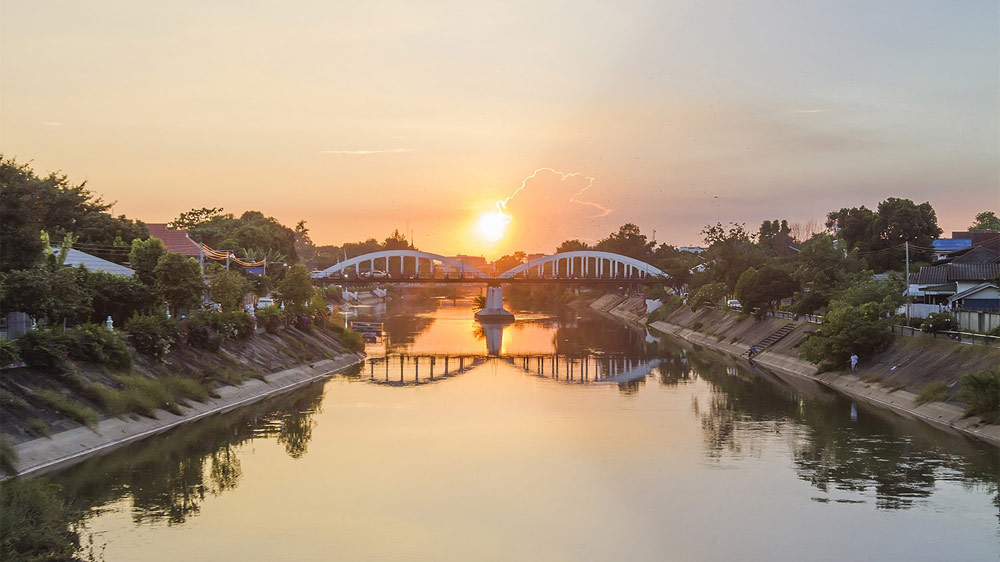
AT the base of the bridge is Ratsada market or Lampang people called Kad Hua Kao, which is a market that been around for long time. If anyone wants to experience the morning market that Lampang people shopping for food should come here. In the market are both fresh and cooked food, food, dessert, local food and fruit that can buy and eat there. Food there is not expensive at all, warmed sticky rice wrap with banana leave that is big enough for 2 -3 people is only 10 baht. And if you walk a lit further will find the first sticky rice roasted in bamboo joints shop in Lampang where they make this fresh every day.
Address: Ratsada Rd. (Wang River), Mueang Lampang,Lampang
Thai Elephant Conservation Center (ศูนย์อนุรักษ์ช้างไทย)
The Thai Elephant Conservation Center (TECC), founded in 1993 under Royal Patronage, cares for more than 50 Asian elephants in a beautiful forest conveniently located near the famous city of Chiang Mai. Beyond being an exciting tourist experience, the TECC is also known for its pioneering work in conservation and science. The TECC also proudly houses six of HM King Bhumibol's ten white elephants in the Royal Elephant Stables.
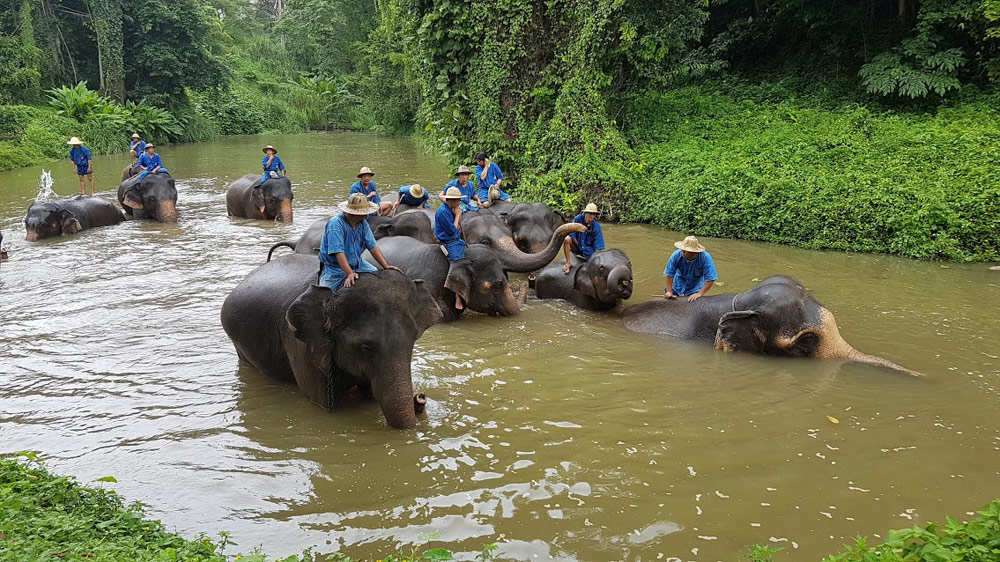
Inside the center there is also an elephant hospital that treats the sick elephants for free. There are many elephants were admitted. Visitors can visit sick elephants or support fees. The Thai Elephant Conservation Center offers clean, inexpensive, affordable accommodation.
Address: Wiang Tan, Hang Chat District, Lampang
Tell: 054 829-333 054 829-322 054 829-331
Kad Kong Ta (กาดกองต้า)
This area was called Kad Kong Ta in the local dialect, translates as “the market on the road by the port. During the reign of King Rama V, Gong Ta was the main commercial centre of the northern Thai teak trade and home of several large British and Burmese logging companies. Chinese traders were also prominent amongst the growing trading community of the 19th century, providing food and merchandise necessary for life at the time and giving the road it’s other name of Talad Chin (Chinese Market).
The interesting mixture of this colonial trading community is represented in the well-preserved buildings and houses dotted along the road, constructed in a variety of Chinese, European and Burmese architectural styles, some of which have been tastefully renovated into gift shops, cafes and guest houses.
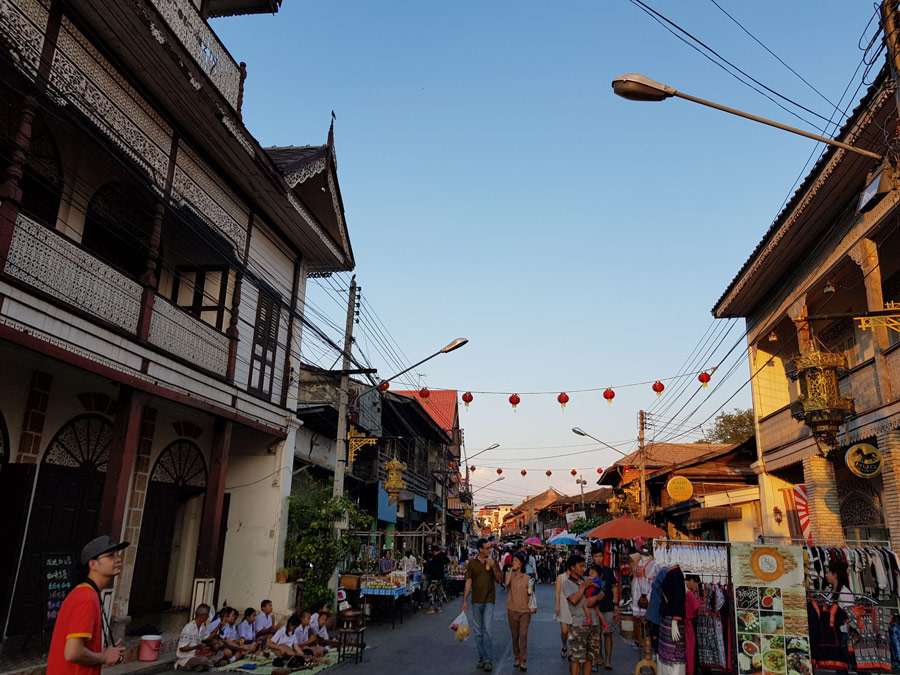
Every weekend evening, the street is closed to traffic from 4pm to 10pm and transforms into a Walking Street Market (similar to the one in Chiang Mai) and fills up with local traders and craftsmen selling souvenirs, handicrafts, clothes, antiques and local food. The market also provides nightly traditional Thai musical entertainment along the river bank.
Address Old Market Street, Mueang District, Lampang
Lampang Horse-Drawn Carriage (รถม้าลำปาง)
When think of Lampang, most people will think of Horse-Drawn Carriage the symbol of Lampang. During King Rama V era. At that time, the city of Lampang was governed by Don Bunyawat Wongmanit. During that period, under European influence, horse carriages were brought to Thailand. The first horse carriages came from Bangkok where they were the main transport for government officers in the capital city. The horse carriage was used in many upcountry areas in Thailand. Lampang is the only province to continue using them.
If you want to take a ride around the city it cost 200 baht for small round and 300 baht for big round. Or you can pay by hour, it’s 400 baht per hour and you can stop at the places you need.
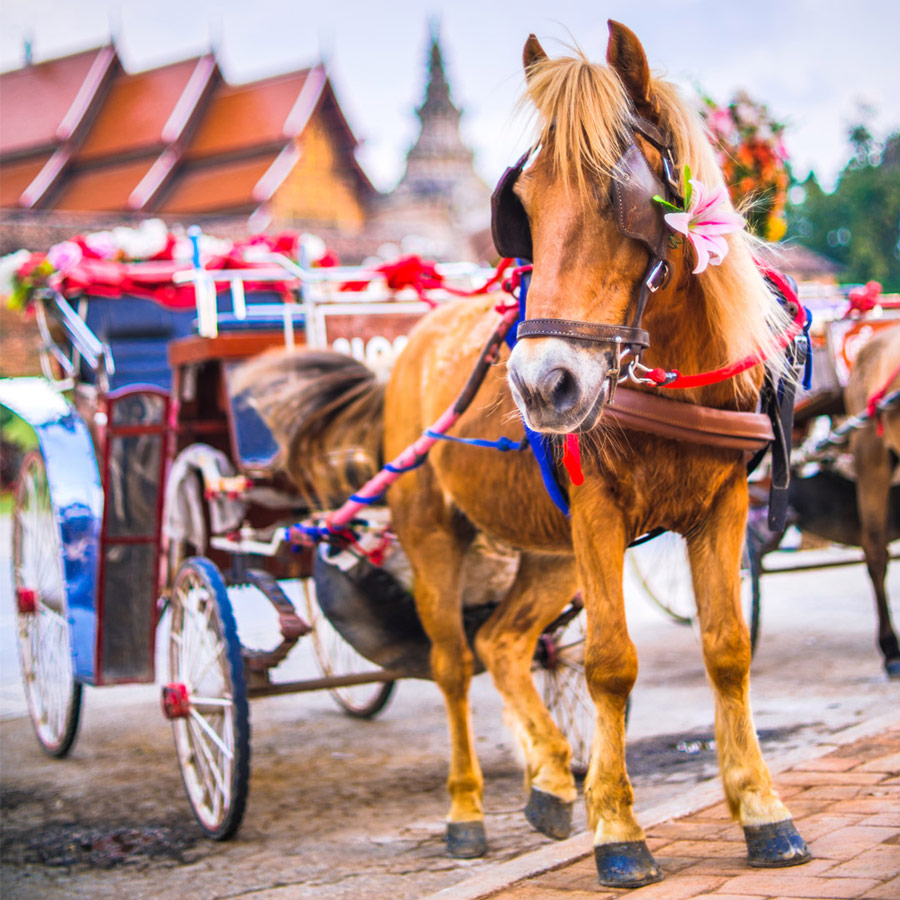
Baan Sao Nak (บ้านเสานัก)
Nak is a northern dialect means a lot of. And this name came from this house that built on stilts up to 116 trees together over a hundred years. The owner is a baron named Mong Chan Ong (descent of Juntraraviroj family). You should not miss this place because it is one of the most beautiful architecture in Lampang. It is a teak house mixed with Burmese art and Lanna art. In the past used to be a guest house on a regular basis. This house has been well maintained and received the best architectural conservation awards in private homes category. Today, it is a museum of arts and crafts. Exhibits the old-fashioned furniture of Thailand and Burma. Visits are available daily from 10 am to 5 pm and are open for banquets and weddings as well
Address: Pahmai, Tambon Wiang Nuea, Amphoe Mueang Lampang, Chang Wat Lampang
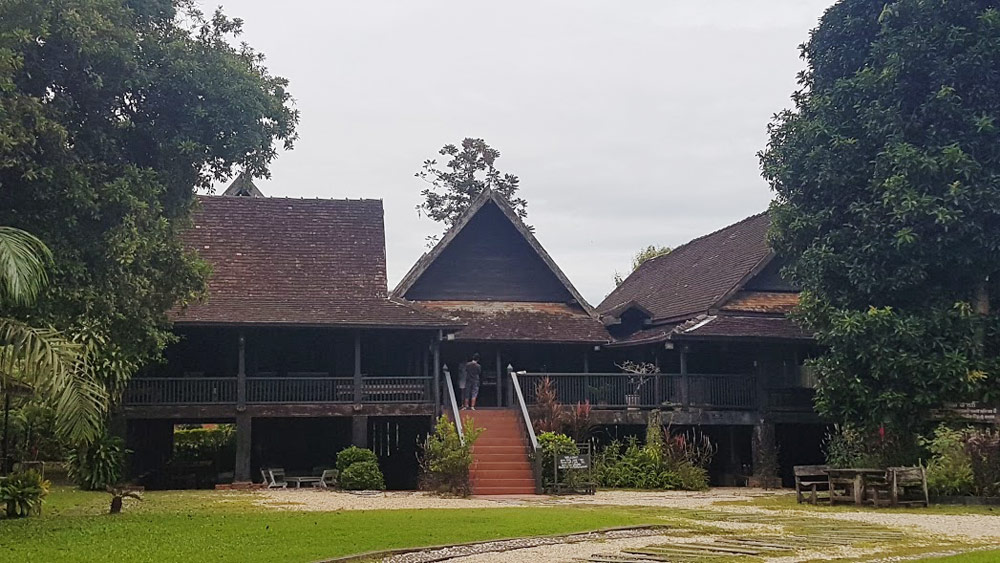
Dhanabadee Ceramic Museum (พิพิธภัณฑ์เซรามิกธนบดี เซรามิก)
Earthenware And ceramic is considered the name of the city of Lampang because here is a ceramic city of Thailand. Especially the chicken bowls which have been seriously produced here for long ago. There are many sources to shop here and Koa Ka district is also a famous place to go.
Who wants to study the history of ceramics and origins of Chicken Bowls from pioneering to today? People found the white stone, the main raw material for making and establishing the first ceramic factory in Thailand. Demonstration made of traditional ceramics. Watch the ancient 100 year old dragon oven. If you are interested in those things just Visit Dhanabadee Ceramic Museum. After seeing all exhibition, you can shop high Quality Ceramic there.
Address: Mueang Lampang District, Lampang
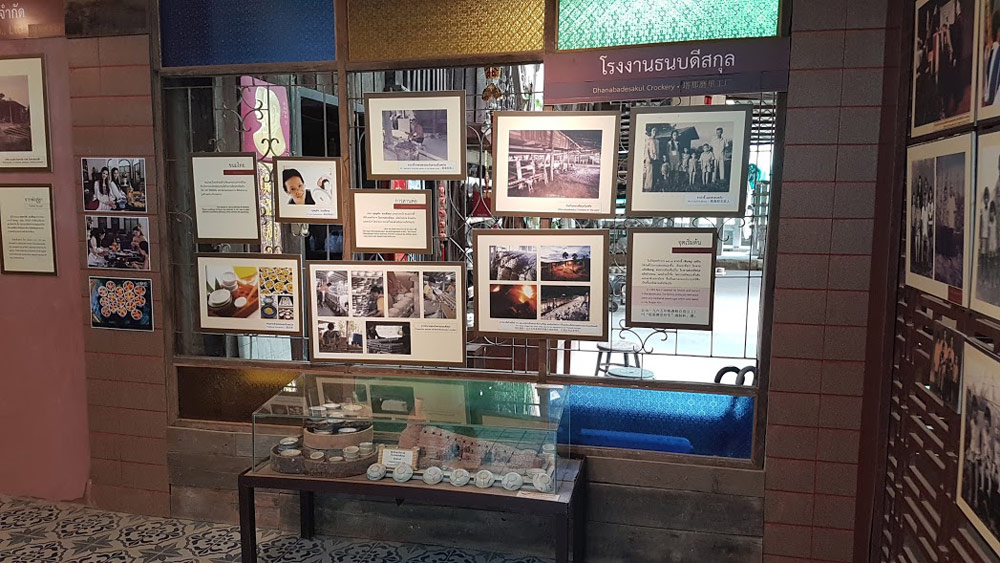
Chae Son National Park (อุทยานแห่งชาติแจ้ซ้อน บ้านป่าเหมี้ยง)
Here is the miracle place, both waterfalls and hot springs are within the same park. The forest is rich with many natural resources. There are nine wells, and the smell of sulfur is quite soft. Average heat temperature is 73 degrees celsius. Visitors love to soak egg in the hot spring for about 17 minutes then it will be well cooked, or we like to call this Onsen egg. Who likes to go to Onsen in Japan, here there is an outdoor bath with international standards, so we can soak in the same mind.
From the hot spring to about 1 km will be a Chae Son waterfall, 6-storey waterfall, which originated from Mon river. The water flows all year round and It looks very beautiful but not suitable for swimming. The best time to visit is November – February when the weather is nice and cool.
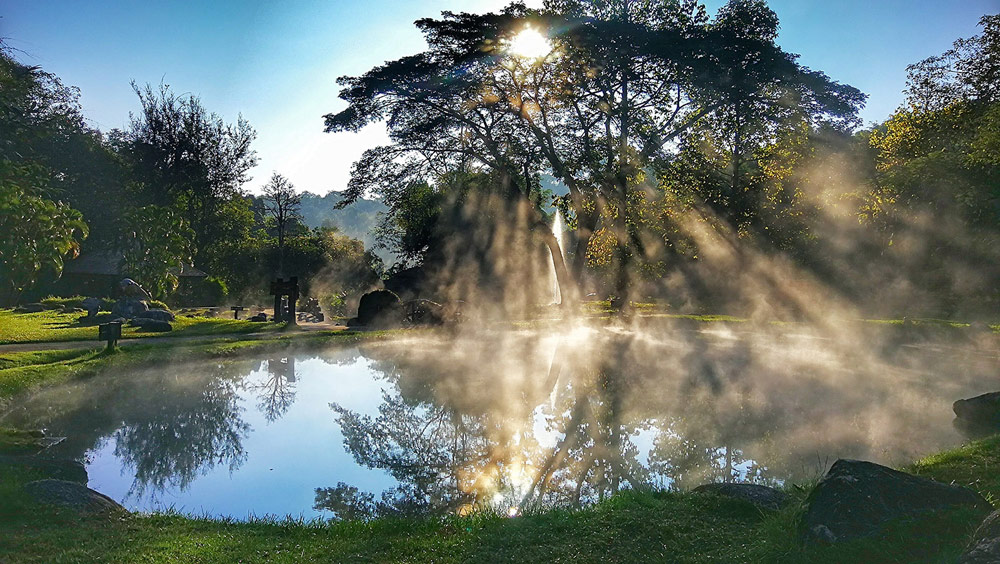
About 14 km from the park, it is another interesting attraction, Baan Pa Meiang. The highlights of this place are the Seaw flowers, beautiful white flowers blooming throughout the valley. Around the month of love, February, is very romantic, and every year there will be a festive bouquet of flowers to the delight of the Lampang people and foreigners.
Address: Chae Son, Mueang Pan District, Lampang
Tree Marigold Field at Mae Mo (ทุ่งดอกบัวตองแม่เมาะ)
For flower lovers there is another program that offers. The Tree Marigold Field. The bright yellow tree marigold bloomed in a field full of 500 rai in Mae Moh mine park, The Electricity Generating Authority of Thailand. In the morning it is cool and foggy.
In the evening, you can watch the beautiful sunset. Have fun with the view point where it is good for selfi. The best time to visit is from November to mid-December. It will be open daily from 07:00 to 19:00.
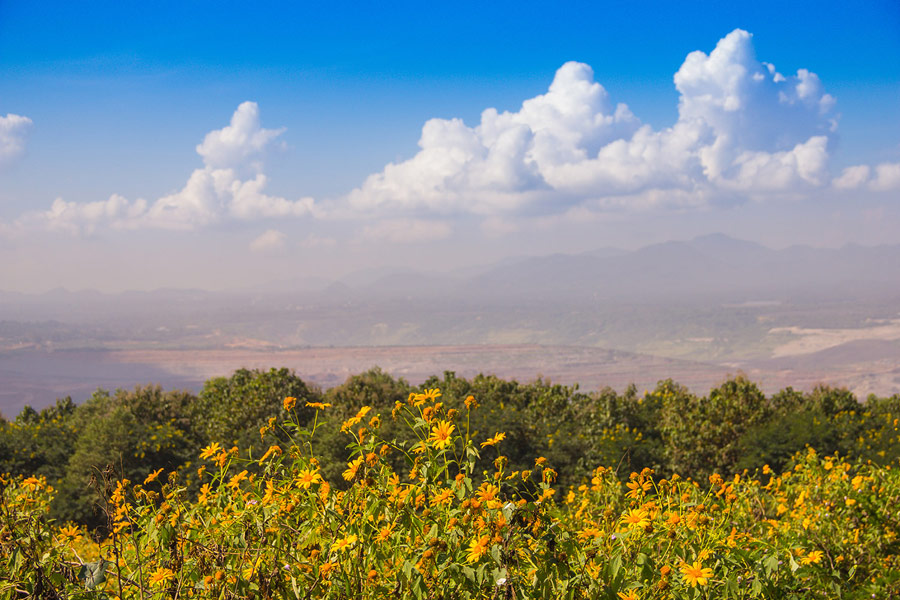
Besides the tree marigold flower. There are other ornamental flowers, flowering alternately to see the whole year, such as the legume, cassia, indian cork, White Champaka, Organge Champaka, Paper flower etc. Or if you want to stay overnight, Mae Moh Mine has accommodation for you to experience the natural way of life that is private and peaceful.
Address: Mae Mo district, Lampang
Delicious food in Lampang
Deliciousness of Lampang food is not less than anywhere else. Food lover people will love it for sure.
- Local food recipes must be traditional: Mae Ha restaurant
- Rice noodles with spicy pork sauce: Aunty Boonsri Restaurant
- Regular restaurant with variety menu: Lai Kram Restaurant, Sabieng
Restaurant, Osha Restaurant, Aroi Baht Deaw - Coffee lover: Him Wang café, Homsukko Café, Chita Café, Mong Ngosin café, Tin Thai café, Teaspoon No.17
This trip to Lampang I ate well and got a warm sleep. If you have chance, try to visit Lampang. You will love it there.
